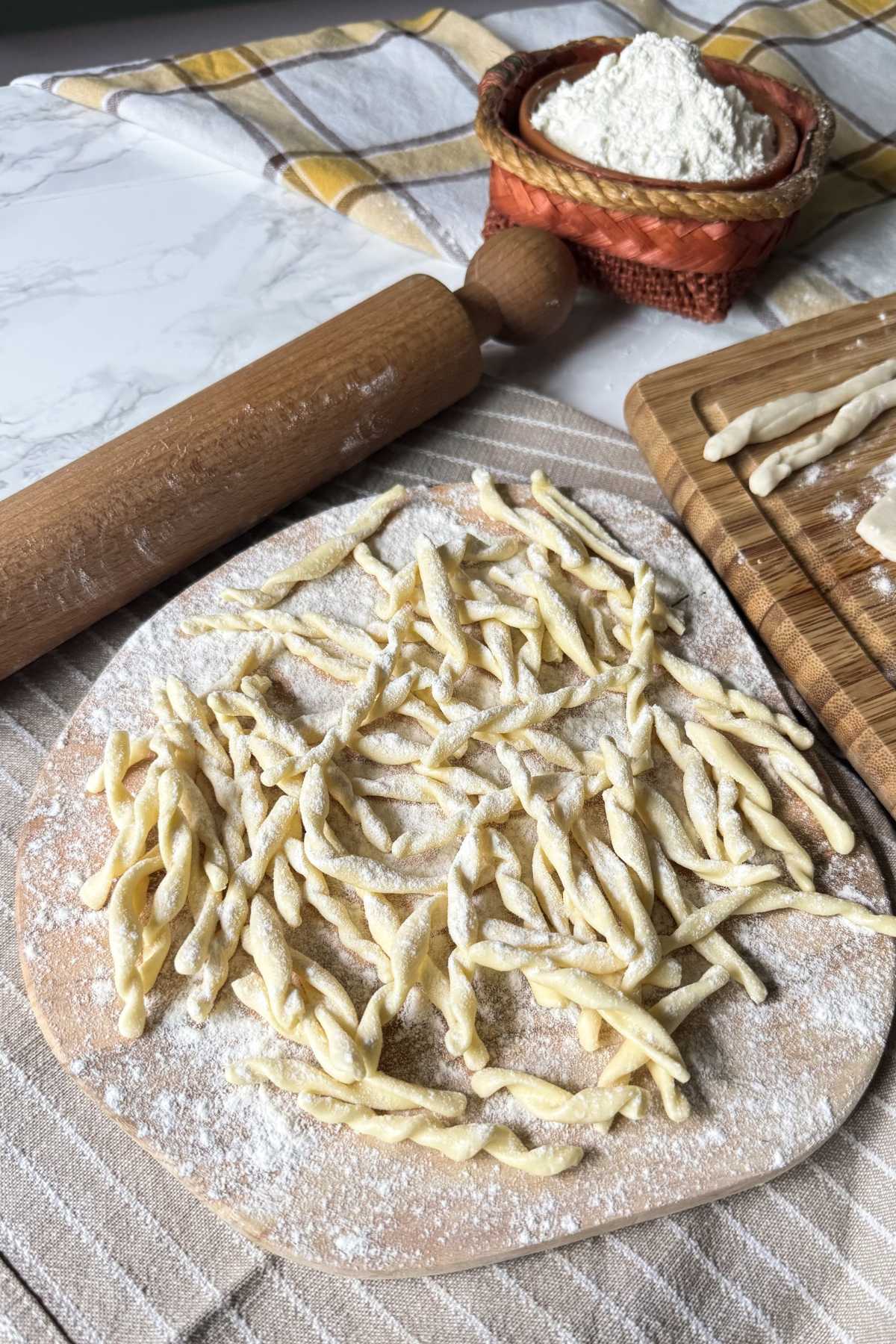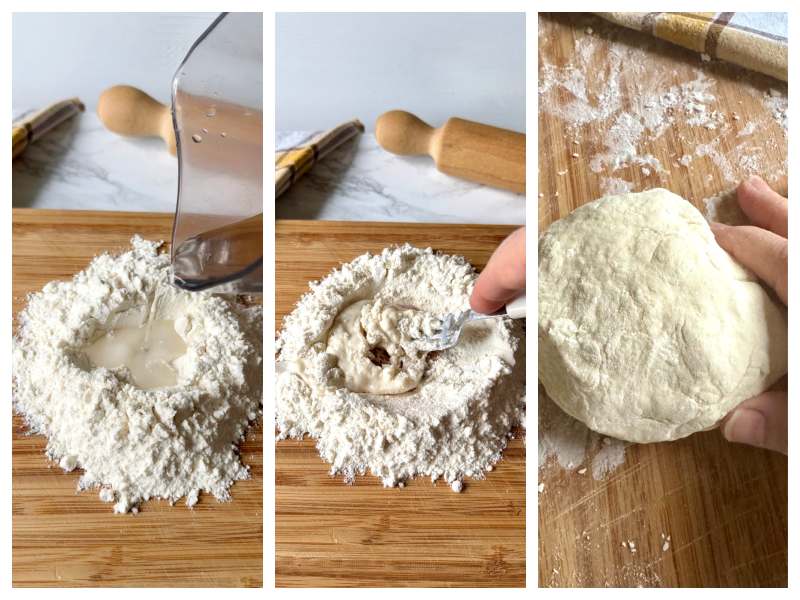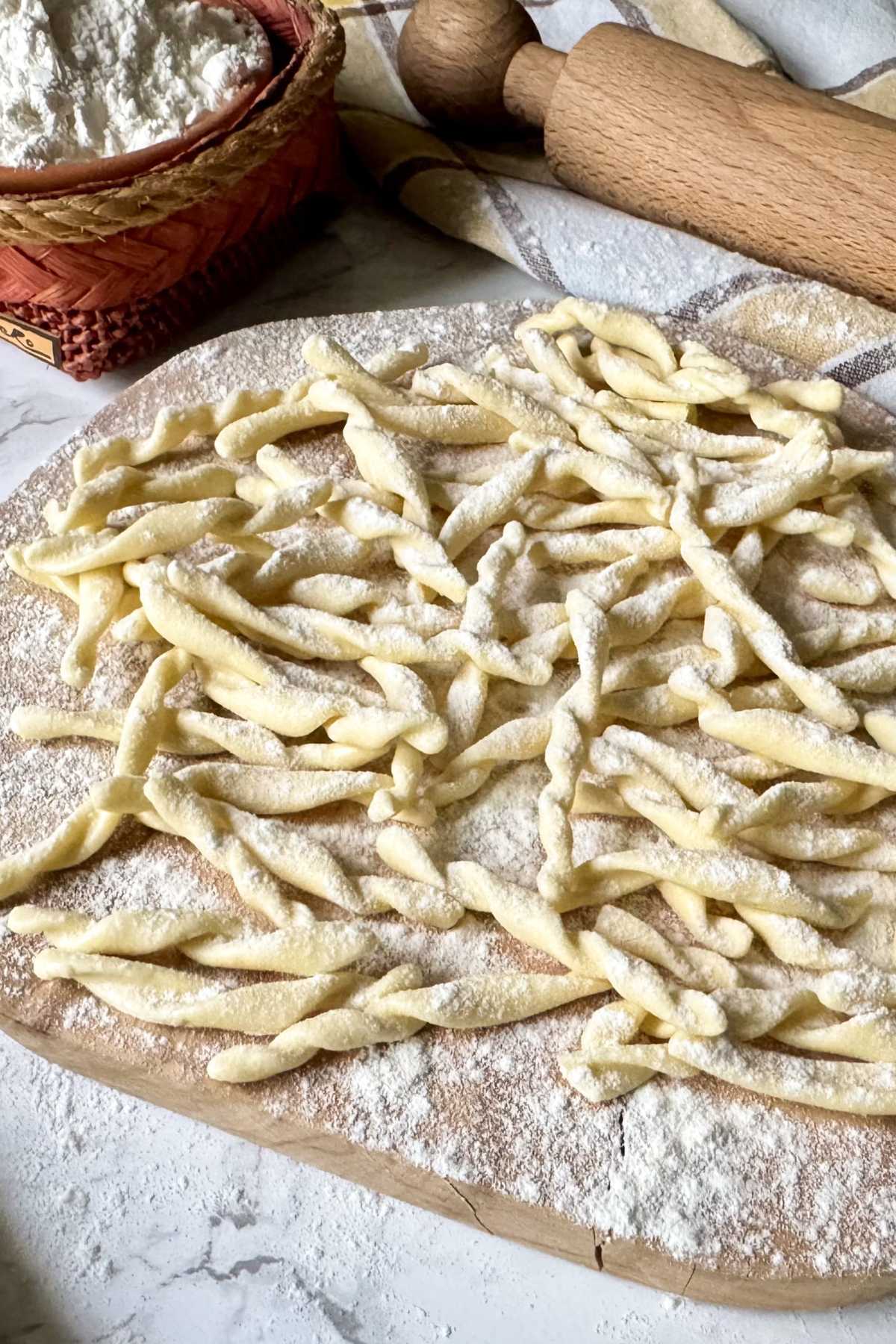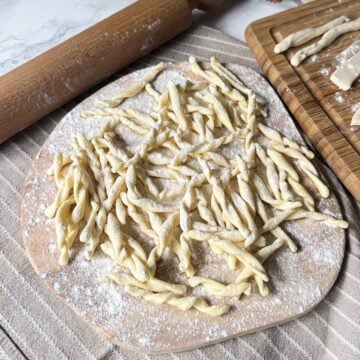Strozzapreti is a type of pasta popular throughout Italy, especially in the northern and central regions. Its origin dates back to the Romagna tradition. Like many regional Italian recipes, there are several local variations. The one I’m sharing here is the most common version from Emilia-Romagna.
Strozzapreti is characterized by its twisted shape, similar to a rope. The dough is made without eggs and requires only two simple ingredients: flour and water. These are long, hand-rolled strings of pasta that are twisted and cut into short pieces about 7–8 cm (3 inches) long.

Making strozzapreti at home is easy and doesn’t require any special equipment, just a bit of manual skill to twist the dough and create their typical shape.
Strozzapreti is a rustic and versatile kind of fresh pasta that pairs beautifully with a wide variety of sauces: from classic ragù alla Bolognese to seafood sauces, vegetable-based condiments, or even a simple butter and sage sauce. Their rough texture and twisted shape make them perfect for holding any sauce.
Homemade strozzapreti are ideal for a Sunday family lunch or a special dinner with friends.
Follow my step-by-step instructions and tips to make authentic Italian strozzapreti at home!
Jump to:
Ingredients

Prep Time: 40 Min | Resting Time: 30 Min | Servings: 4
- 400 g (2 ⅔ cups) 00 flour
- 200 ml (¾ cup +1 tablespoon) water
- ⅓ teaspoon fine salt (optional)
Instructions
Make the Dough

Step 1) – To make homemade strozzapreti, start by placing the flour on a wooden board or work surface and forming a mound. Add a pinch of fine salt if you like, then make a well in the center.
Slowly pour the water into the well, little by little, and start mixing it with a fork, gradually incorporating the flour from the edges. When the dough begins to come together, use your hands to knead it directly on the board.
Knead for about 5 minutes, or until the dough becomes smooth, soft, and elastic.
NOTE: If the dough feels too sticky, sprinkle in a little more flour until it reaches the right consistency.

Step 2) – Shape the dough into a ball, wrap it in plastic wrap, and let it rest at room temperature for about 30 minutes. This resting time helps the gluten relax, making the dough easier to roll out.
After resting, lightly flour your work surface and roll out the dough with a rolling pin until it’s about 3 mm (⅛ inch) thick. Then, using a smooth-bladed knife, cut long strips about 1.5 cm (½ inch) wide.
Shape the Strozzapreti

Step 3) – Take one strip at a time and roll it gently between the palms of your hands to form long, thin ropes of dough. Cut each rope into pieces about 7–8 cm (3 inches) long — these will be your strozzapreti.
As you shape them, place the finished strozzapreti on a floured tray or board to prevent them from sticking together. Continue until all the dough is used.
NOTE: When making strozzapreti, try to keep the pasta even in size and thickness, both when rolling out the dough and when cutting the strips. This ensures that all the pieces cook evenly and in the same amount of time.

Storage
Homemade strozzapreti are best enjoyed fresh, right after they’re made. If left too long, they can stick together and lose their texture.
If you want to keep them longer, you can dry them. Spread the strozzapreti on a clean surface and cover them with a cloth. Once completely dry, store them in a cool, dry place, they will keep for up to one month.
Alternatively, you can freeze them. Arrange the strozzapreti on a tray in a single layer and place them in the freezer. Once frozen, transfer them into freezer bags. This way, they won’t stick together and will be ready to cook whenever you like.
How to Serve Strozzapreti
Like all types of homemade pasta, strozzapreti cooks very quickly.
Drop the strozzapreti into a large pot of boiling salted water and cook for about 4 to 5 minutes. The exact cooking time may vary depending on their thickness, but as a general rule, when they float to the surface, they’re done. Taste one to check the texture before draining.
Once cooked, it’s time to choose your favorite sauce.
Strozzapreti pairs beautifully with rich meat sauces such as ragù alla Bolognese or alla Boscaiola, but it’s also perfect for seafood dishes. Try strozzapreti allo scoglio, following the traditional spaghetti recipe, or toss them with a simple clam sauce for a lighter option.
This rustic pasta goes well with almost any kind of sauce. Even dressed simply with butter, sage, and Parmigiano Reggiano cheese, or with a classic tomato and basil sauce, it’s absolutely delicious.

Tips
In some parts of Romagna, a couple of tablespoons of fine breadcrumbs are added to the flour to give the dough a more rustic texture.
Since strozzapreti pasta is made without eggs, it’s also perfect for those following a vegan diet. If you pair it with a sauce made entirely from plant-based ingredients, you’ll have a delicious and authentic Italian vegan dish.
When making strozzapreti, try to keep the pasta even in size and thickness, both when rolling out the dough and when cutting the strips. This ensures that all the pieces cook evenly and in the same amount of time.
Origins and History
Like many traditional Italian pastas, Strozzapreti has an interesting story behind its curious name, which literally means “priest stranglers.”
This pasta originated in Romagna during the time of the Papal States, when priests imposed heavy taxes on the locals. According to legend, housewives (known in dialect as azdore) had to hand over their eggs to the Church. Left without eggs to make pasta, they created a new dough using only flour and water, while half-jokingly wishing the priests would choke on their food.
Another version tells that priests were often invited to Sunday lunches, where they ate so much of this delicious pasta that locals joked it might “strangle” them.

Strozzapreti Across Italy
Be aware that ordering strozzapreti in different regions of Italy doesn’t always mean you’ll get the same dish. The name varies, and so do the recipes.
In Romagna, strozzapreti are short, hand-rolled strands of eggless pasta; this is the most traditional and well-known version.
Elsewhere in Italy, the same name refers to entirely different dishes:
- Strangulaprevati from Salento: small potato gnocchi, typically served with ricotta.
- Strangolapreti from Trentino: bread and spinach dumplings served with butter, sage, and sometimes speck.
- Tuscan Strozzapreti (or Gnudi): soft ricotta and spinach balls, essentially “naked” ravioli without the pasta shell.
- Strangozzi from Umbria: long, rectangular pasta made with flour and water, often served with truffles.
More Italian Homemade Pasta Recipes Without Eggs
If you love traditional Italian handmade pasta without eggs, don’t miss our other authentic recipes!
- Orecchiette Pasta from Puglia – famous for its little “ears” shape that perfectly holds any sauce.
- Trofie Pasta from Liguria – a short, twisted pasta traditionally served with basil pesto.
- Malloreddus Pasta from Sardinia – also known as Sardinian gnocchi, small ridged shells made only with semolina flour and water.

Recipe Card

Homemade Strozzapreti Pasta from Emilia-Romagna
Ingredients
- 400 g 00 flour - 2 ⅔ cups
- 200 ml water - ¾ cup +1 tablespoon
- ⅓ teaspoon fine salt - optional
Instructions
Make the Dough
- Start by placing the flour on a wooden board or work surface and forming a mound. Add a pinch of fine salt if you like, then make a well in the center.
- Slowly pour the water into the well, little by little, and start mixing it with a fork, gradually incorporating the flour from the edges.
- When the dough begins to come together, use your hands to knead it directly on the board. Knead for about 5 minutes, or until the dough becomes smooth, soft, and elastic.If the dough feels too sticky, sprinkle in a little more flour until it reaches the right consistency.
- Shape the dough into a ball, wrap it in plastic wrap, and let it rest at room temperature for about 30 minutes. This resting time helps the gluten relax, making the dough easier to roll out.
- After resting, lightly flour your work surface and roll out the dough with a rolling pin until it’s about 3 mm (⅛ inch) thick.
- Then, using a smooth-bladed knife, cut long strips about 1.5 cm (½ inch) wide.
Shape the Strozzapreti
- Take one strip at a time and roll it gently between the palms of your hands to form long, thin ropes of dough.
- Cut each rope into pieces about 7–8 cm (3 inches) long — these will be your strozzapreti.
- As you shape them, place the finished strozzapreti on a floured tray or board to prevent them from sticking together. Continue until all the dough is used.





Leave a Reply